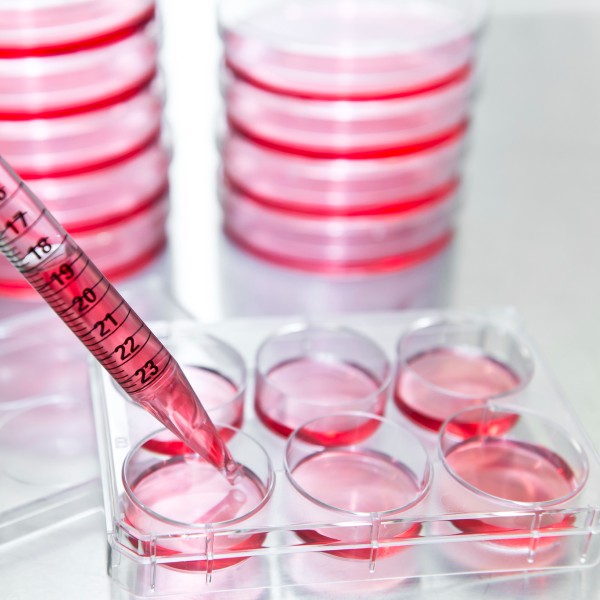Watch our recent talk at the 2021 Industrializing Cell-Based Meats and Seafood Summit. Watch Now >>
“It is believed that at the industrialized scale of production, cell culture media costs will make up between 55% to 95% of the marginal costs of the meat product.”
Compared to the traditional livestock approach to meat production, cultured meat, at scale, is projected to require less water, land, feed, and labor. Also, suppose the cultured meat process can have no loss during production. In that case, it will present another benefit since waste management and the inefficient harvesting from whole animal carcasses are currently unsolvable issues with livestock. That said, cultured meat production will not be free of waste and costs. A white paper by the Good Food Institute projects that cell culture media will be the most significant cost driver to cultured meat. It is believed that at the industrialized scale of production, cell culture media costs will make up between 55% to 95% of the marginal costs of the meat product. Nevertheless, there are numerous ways to lower costs with basal cell culture media optimization and the selection of appropriate growth factors, as discussed below.
Early approaches to culturing meat have used additives like fetal bovine serum (FBS) as a growth supplement. The proteins, growth factors, cytokines, cholesterol, and fatty acids in serum allow for broad adoption across various cell culture applications. However, FBS can be costly, variable in its composition, limited in supply, and not sustainable because it is an animal-derived component. Broad commercial acceptance by vegetarians and vegan customers will be limited or non-existent because the final product will not be from an entirely slaughter-free process. Moreover, there could be reservations from various religious groups who might not deem the collection or use of serum as acceptable (e.g., Halal, Kosher, or Hindu consumers). Therefore, there are focused efforts from both industry and academia to develop recombinant, cruelty-free, or plant-based supplements with the same or better growth characteristics as FBS.

A team at Maastricht University has recently reported on the feasibility of cultured meat production without serum supplementation. Routinely, bovine myoblasts have been cultured in advanced DMEM media with 20% FBS, 10% horse serum, and antibiotics. The research team tested if chemically-defined media alone or with alternative supplements could grow cells and traditional serum-supplemented media. In both media platforms, the exclusion of antibiotics led to at least a 20% increase in cell growth. Yet, over time purely chemically-defined media without the addition of growth supplements suffered from inferior cell growth compared to serum-supplemented media formulations. In fact, only three serum-free media types resulted in any noticeable cell growth after six days. The best serum-free media was a mixture of half DMEM with half fibroblast basal media FBM containing a lipoprotein supplement. Unfortunately, despite the increased growth, the lipoprotein supplement changed the phenotype of some myoblasts away from muscle fibers to an undesirable adipocyte-like phenotype. Moreover, because the lipoprotein supplement was derived from a serum-based cholesterol concentrate, it could not be considered a fully sustainable or animal-free option. Finally, when additional growth factors like FGF-2, EGF, IGF, and insulin were added to this mixed media, the cell proliferation at least doubled in the cultures.
There are other cell culture media formulation modifications to be aware of too. For example, heme proteins, especially myoglobin supplementation, have improved cell proliferation and cell doubling times by more than 10%. Also, adding either myoglobin or hemoglobin to the media enhanced the color of the cell-based meat, although the levels of pigmentation were still much lower than the levels measured from beef samples. However, there is also the concern that these proteins are sourced from animals, so they do not create a genuinely animal-free cell culture media. Additionally, animal-free origin hydrolysates derived from plants or yeast culture could also be used as supplements to increase growth of these cells as is often done in the biopharmaceutical industry.
It is hoped that as the cultured meat industry continues to advance, we will start seeing innovative approaches to developing entirely animal-free cell culture media. Aside from the issues of animal-derived cell culture media components, there are other considerations of large-scale cell culture media usage like the stability of the media to environmental conditions, processing procedures, and the variability of ingredients. The last point may even bring to the market a new class of raw materials that are “cultured-meat grade” to address the industry’s need for some level of reproducible lots of media at an acceptable price. Because cell culture media is one of the costliest and ethically questionable production elements, the formulation must be thoughtfully designed for cultured meat to become a socially and economically acceptable option for consumers.
Cell-Based Meat Process Development Series
- Part 1: An Introduction to the Cell-Based Meat Revolution
- Part 2: The Variety of Process Considerations in Cell-Based Meat Production
- Part 3: How Cell Proliferation for Cultured Meat Production Relies on the Appropriate Microcarrier or Scaffold Selection
- Part 4: The Importance of Cell Culture Media Optimization for Cost and Productivity Considerations in Cell-Based Meat Processes
- Part 5: The Role of Analytics in Cell-Based Meat Production
email Subscribe to Our Communications Signup to receive new product updates, technical tips and more.
